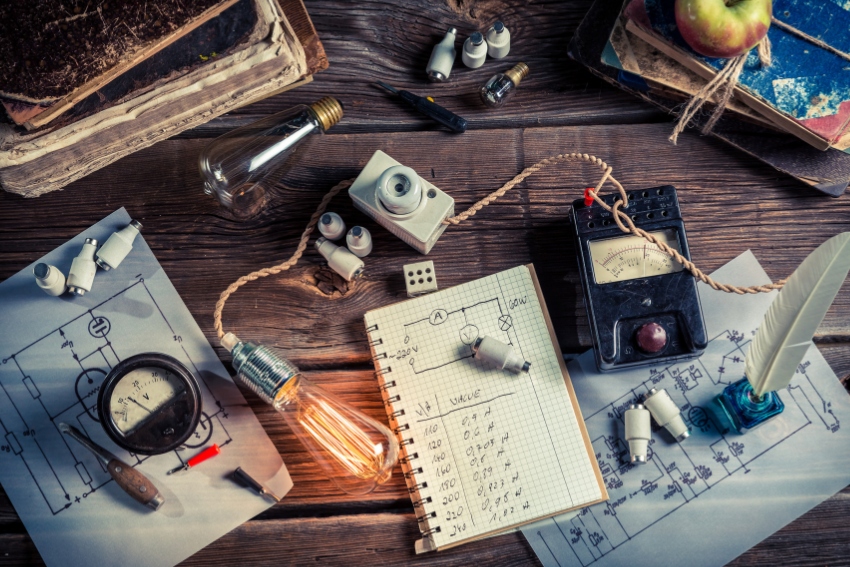Welcome, dear parents, to this comprehensive guide that aims to answer the pressing question: What are relaxation techniques for a child? As most of us are acutely aware, the modern world is a whirlpool of activities, information, and constant stimulation. The impact of this high-energy environment is not limited to adults; it significantly affects our children as well. With increasing academic pressures, extracurricular activities, and even social dynamics becoming more complex, stress and anxiety are no longer conditions that just adults experience. Children, too, are falling prey to these emotional and psychological pressures, and the statistics are nothing short of alarming.
So, whether you’re a parent of a toddler who is showing early signs of anxiety or you’re dealing with a teenager who is struggling to cope with the pressures of school and social life, this guide is tailored to offer practical, step-by-step advice on various relaxation exercises. These methods can be especially helpful on the night before a GCSE exam, when stress levels tend to peak. With the techniques outlined here, you’ll be better equipped to help your child navigate the complexities of modern life with greater emotional resilience.
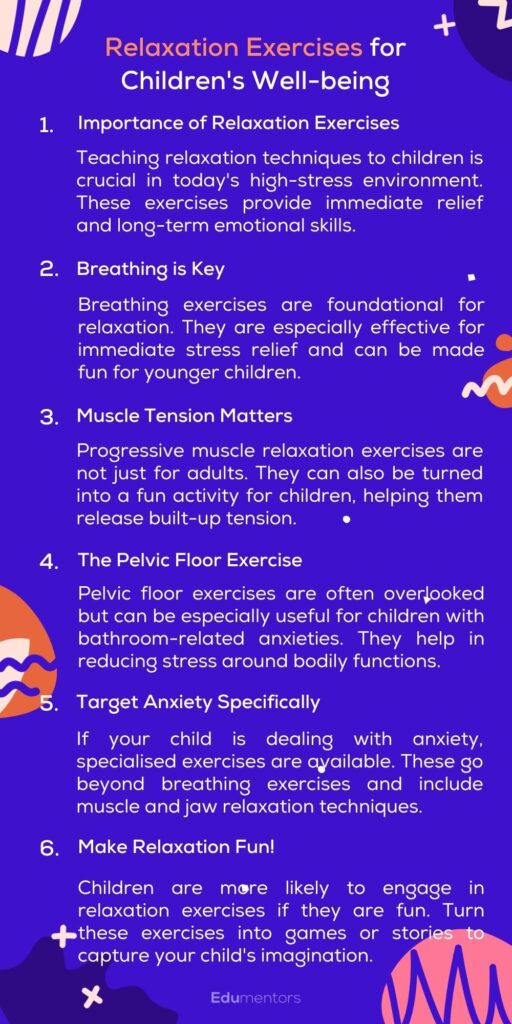
What are Relaxation Exercises?
Types of Relaxation Exercises
When we delve into the topic of relaxation exercises, it becomes evident that this is a broad umbrella term covering various techniques aimed at calming the mind and body. So, what is an example of a relaxation exercise? Well, the spectrum is vast. It ranges from simple breathing exercises that can be done almost anywhere to more intricate methods like progressive muscle relaxation. For children, these relaxation exercises can be tailored to suit their age, preferences, and specific challenges they might be facing.
A unique subset within this category is jaw relaxation exercises. Why are these significant? Many children unconsciously grind their teeth or clench their jaws when stressed. Teaching them jaw relaxation exercises can be a godsend, helping to eliminate one physical manifestation of stress.
Importance of Relaxation Activity
Now, let’s discuss the crucial aspect of relaxation exercises in the context of child anxiety. It’s a sad but true reality that children are not immune to the crippling effects of anxiety disorders. Whether it’s separation anxiety in young children or social anxiety in teenagers, the emotional toll can be detrimental. This is where relaxation exercises for children come into play.
Such exercises go beyond mere suggestions; they are practical tools that can be instrumental in managing various forms of anxiety. From general anxiety to specific phobias and even situations that trigger acute stress, these exercises offer a tangible way to cope. They can be seamlessly incorporated into a child’s daily routine, and the effects can be profoundly positive. Imagine a child equipped with relaxation exercises, courtesy of platforms such as Edumentors; they are better prepared to face the myriad challenges that life throws at them.
Furthermore, it’s not just general relaxation exercises that are beneficial. Specialised exercises targeting particular types of anxiety can be even more effective. For instance, if a child is constantly anxious and restless, specific relaxation exercises for anxiety can be taught to help them gain control over their symptoms.
The beauty of these exercises is that they can be practised almost anywhere, whether it’s at home, school, or during extracurricular activities. Therefore, they are incredibly versatile and adaptable, making them perfect for children who are always on the go.
Breathing Exercises for Relaxation
Deep Breathing Techniques
Breathing exercises for relaxation are often touted as the cornerstone techniques for reducing stress and anxiety, and for good reason. The essence of these exercises lies in their simplicity and effectiveness. Deep breathing, for instance, is a highly recommended method. The mechanics are straightforward: instruct your child to inhale deeply through the nose, allowing the air to fill their lungs and expand their diaphragm. Then, they should hold this breath for a count of three before exhaling fully through the mouth. This act of conscious breathing shifts the focus away from stressors and helps to regulate the body’s stress response. The calming effect is immediate, making it an excellent strategy that your child can use wherever they are.
Simple Breathing Exercises for Relaxation
While deep breathing is effective, it may not hold the attention of younger children for long. That’s where simple breathing exercises for relaxation come in, adding a touch of fun and creativity to the process. For example, you could incorporate visual elements or toys to make the exercise more engaging.
A popular technique is the ‘Toy Rise-and-Fall.’ In this exercise, have your child lie down on a comfortable surface and place a lightweight toy on their stomach. As they breathe in and out, the toy will rise and fall, providing a visual cue that helps them understand the mechanics of deep breathing. This simple yet effective method not only educates them on the principle of deep breathing but also makes the learning experience enjoyable.
Like any skill, the benefits of breathing exercises multiply with consistent practice. Therefore, it’s beneficial to incorporate these techniques into your child’s daily routine. Whether it’s a quick session before bedtime to improve sleep quality or a brief pause during homework to declutter the mind, the opportunities to apply these exercises are endless.
The Universal Utility of Breathing Exercises
What sets breathing exercises apart is their universal applicability. These are not confined to any age group or situation. Whether your child is at home, in school, or even in a stressful situation, a few minutes of focused breathing can work wonders for their emotional state.
Breathing exercises for relaxation are invaluable tools in your child’s stress-management arsenal. With methods ranging from deep breathing techniques to more simple breathing exercises for relaxation designed specifically for children, these practices are versatile and universally applicable. Their simplicity means they can be easily taught, learned, and applied, making them a go-to resource for immediate stress relief.
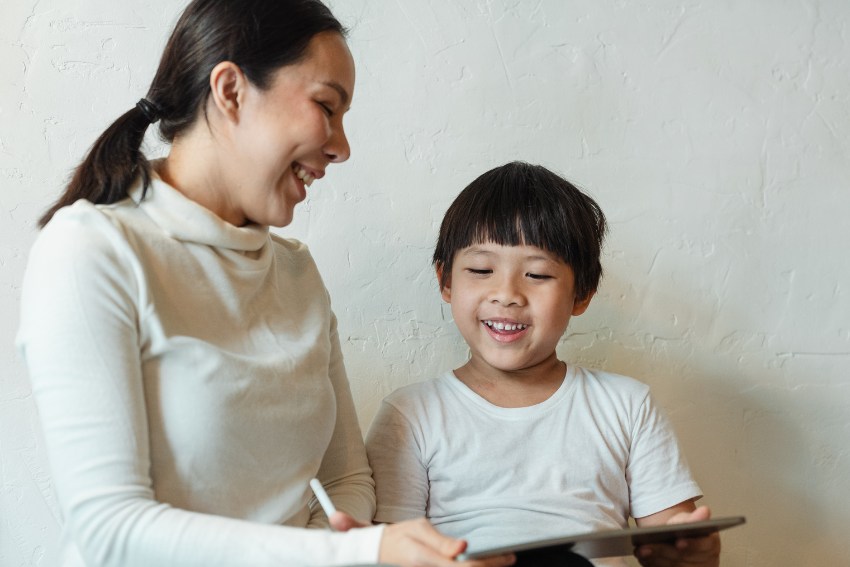
Muscle Relaxation Exercises
Progressive Muscle Relaxation Exercises for Children
When it comes to muscle relaxation exercises, one technique that stands out is Progressive Muscle Relaxation (PMR). This method involves sequentially tensing and relaxing various muscle groups in the body, and it’s incredibly effective for reducing physical tension and mental stress. For children, this can be turned into an engaging activity with the power of imagination. For example, you can encourage your child to pretend they’re a stiff wooden board one moment and then a floppy, relaxed doll the next. This allows them not just to learn the technique but also to enjoy the process, making them more likely to use it regularly.
To make PMR more interactive, you can guide your child through a series of muscle groups, starting from the toes and working your way up to the head. As they tense each muscle group, have them hold the tension for a few seconds before releasing it. The sensation of tension followed by relaxation often provides immediate stress relief and is particularly effective for children who have a lot of pent-up energy.
Jaw Relaxation Exercises
Jaw tension is a frequently overlooked symptom of stress and anxiety, but it’s something that can affect children too. If you notice your child clenching their jaw, especially during stressful situations like exams or conflicts, jaw relaxation exercises can provide quick and effective relief. One straightforward exercise involves having them open their mouth as wide as possible (without causing pain), holding for a few seconds, and then letting it go slack. They can repeat this process several times to ease tension.
Like breathing exercises, the benefits of muscle relaxation techniques, including jaw relaxation exercises, are best experienced through regular practice. Incorporating these exercises into your child’s daily routine can significantly contribute to their emotional well-being. You can even combine these with breathing exercises for a comprehensive relaxation session.
The Flexibility of Muscle Relaxation Techniques
One of the advantages of muscle relaxation exercises is their versatility. Whether it’s progressive muscle relaxation exercises for children or targeted jaw relaxation exercises, these techniques can be adapted to suit your child’s specific needs and preferences. These exercises are also not confined to any particular setting; they can be practised at home, in school, or even while travelling.
Muscle relaxation exercises offer a versatile set of tools for stress and anxiety management, suitable for children of all ages. Techniques like Progressive Muscle Relaxation and jaw relaxation exercises not only alleviate tension but also empower children with the skills to manage their stress levels proactively.
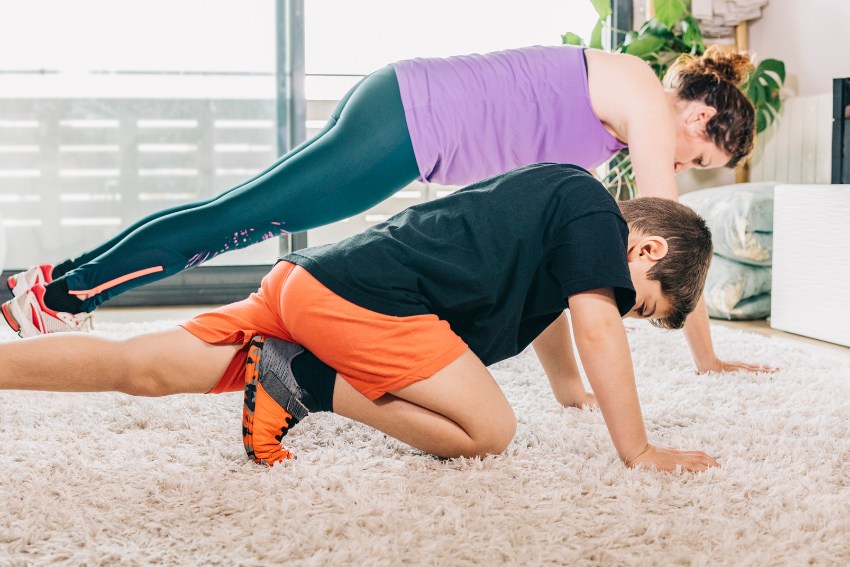
Pelvic Floor Relaxation Exercises
What Are Pelvic Floor Relaxation Exercises?
Pelvic floor relaxation exercises focus on the group of muscles that form the base of the pelvic area. These muscles are critical for various functions, including bladder and bowel control. While most conversations around pelvic floor exercises tend to revolve around adults, particularly women post-childbirth, their relevance extends to children as well.
When it comes to bathroom-related anxieties, such as fears of using public restrooms or concerns over bedwetting, pelvic floor relaxation exercises can serve as a practical solution. These exercises can help children gain better control over their pelvic muscles, which in turn can alleviate anxiety and improve their confidence.
How to Introduce Pelvic Floor Relaxation Exercises to Children?
Introducing pelvic floor relaxation exercises to children should be done cautiously and sensitively. It’s essential to explain the purpose of these exercises in age-appropriate language. For younger children, you might describe it as a “superpower” that helps them control their bathroom habits better. For older kids, a more anatomical explanation might be more suitable.
The exercises themselves are simple. Teach your child to identify their pelvic floor muscles by stopping urination mid-stream. Once they’re familiar with the muscles, they can practise contracting and relaxing them. Initially, it’s helpful to do this under the supervision of a healthcare provider who can ensure that the technique is correct.
The advantages of pelvic floor relaxation exercises extend beyond just alleviating bathroom-related anxieties. Improved control over these muscles can also lead to better posture and overall physical stability. In some cases, it can even alleviate lower back pain, making it a multipurpose tool in your child’s wellness toolkit.
Like any other form of exercise, the benefits of pelvic floor relaxation exercises are most noticeable when practised consistently. It’s a good idea to incorporate these into your child’s daily routine, perhaps as part of their morning or bedtime rituals.
Pelvic floor relaxation exercises offer an effective, albeit less commonly discussed, avenue for managing specific types of anxiety in children. With consistent practice and proper technique, your child can gain better control over their pelvic muscles, reducing anxiety and boosting their overall well-being.
Relaxation Exercises for Anxiety
It’s crucial to recognise the increasing rates of anxiety disorders in children. The figures are startling, and as parents, educators, or caregivers, we must arm ourselves with the tools to help these young minds navigate their emotional landscapes.
While generic relaxation exercises can certainly offer benefits, children with anxiety disorders often require more targeted interventions. This is where relaxation exercises specifically designed for anxiety come into play.
For a comprehensive approach to managing anxiety, consider combining different types of relaxation exercises we already mentioned above. You might start with breathing exercises to calm the immediate fight-or-flight response and then transition into muscle or jaw relaxation methods for sustained relief.
Your role as a parent is crucial in teaching and reinforcing these techniques. It’s not just about showing them the exercises but also about creating an environment where they feel safe enough to practise them. Discuss the different options with your child and let them choose the techniques they find most comfortable. The objective is to empower them to manage their anxiety proactively.
Relaxation exercises for anxiety offer a multi-faceted approach to managing this complex emotional condition. By teaching your child a range of techniques, from breathing to muscle relaxation, you equip them with a toolkit to tackle their anxiety head-on.
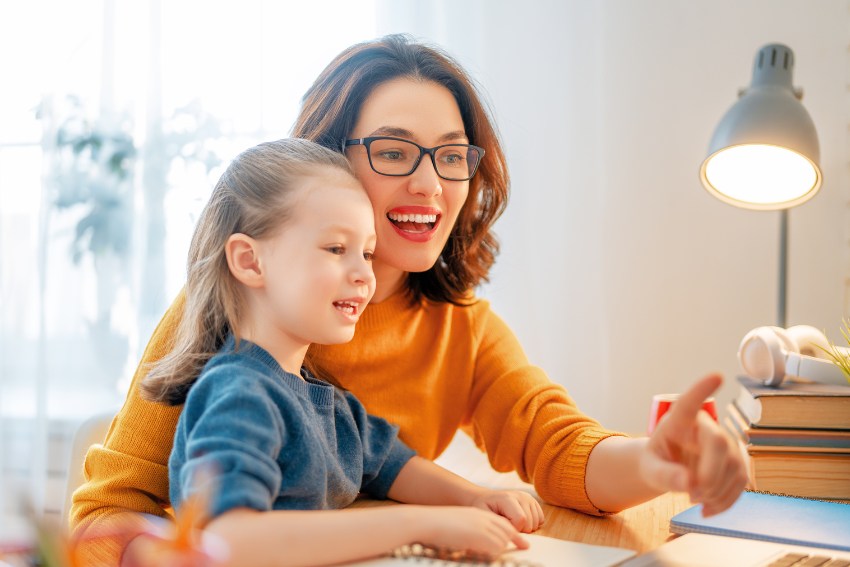
Relaxation Exercises for Sleep
Adequate sleep is vital for everyone but especially so for children, who are in a crucial phase of growth and development. Lack of sleep can not only affect their health but also their performance in school and social interactions. This makes it all the more important to introduce relaxation exercises for sleep.
Children with anxiety often find it difficult to sleep, and lack of sleep can, in turn, exacerbate their anxiety. Breaking this vicious cycle is essential, and targeted relaxation exercises to help you sleep can be the key.
Progressive Muscle Relaxation
Progressive muscle relaxation exercises for children are particularly beneficial when it comes to promoting sleep. These exercises involve tensing and relaxing different muscle groups, which not only relieves tension but also tires out the muscles. This prepares the body for a restful sleep and can be an effective part of your child’s bedtime routine.
Breathing Exercises
Breathing exercises can also be tailored to promote better sleep. Techniques like “box breathing,” where you inhale, hold, exhale, and hold for four counts each, can slow down the heart rate and prepare the body for sleep. This is a straightforward yet effective relaxation exercise to help you sleep.
The Power of Visualisation
Another method to consider is guided imagery or visualisation. Ask your child to imagine a serene setting, like a beach or a meadow, and to focus on the sensory details of that setting. This can divert their mind from anxious or stressful thoughts and make the transition to sleep easier.
Incorporating these relaxation exercises into a consistent bedtime routine can drastically improve your child’s sleep quality. Begin with some light stretching or progressive muscle relaxation, followed by breathing exercises, and perhaps conclude with a brief session of guided imagery.
As a parent, your involvement doesn’t end with merely teaching these exercises. Ensuring a conducive environment for sleep, like a dark, quiet room, can significantly enhance the effectiveness of these relaxation exercises for sleep.
When sleep becomes a casualty of stress or anxiety, it’s time to take proactive steps. Armed with a range of relaxation exercises to help you sleep, you can ensure that your child gets the restful and restorative sleep they so critically need.
Fun Relaxation Exercises for Children
For children, the idea of ‘relaxation exercises’ may sound tedious or uninteresting. Therefore, turning these activities into games or integrating them into storytelling can make the process not only enjoyable but also more engaging. This is where fun relaxation exercises for children come into play.

1. Animal Breathing
Imagine turning each breath into a roar, a quack, or a moo! Animal breathing is a creative and fun relaxation exercise for children. Each deep breath can be accompanied by an animal sound, making the activity both entertaining and educational. This method not only makes breathing exercises engaging but also teaches kids about different animals.
2. Treasure Hunt Relaxation Game
In this imaginative game, your child embarks on a treasure hunt, but instead of looking for objects, they are searching for body parts to relax. For instance, when they ‘find’ their hands, they will focus on relaxing them completely before moving on to the next ‘treasure,’ like their feet or shoulders. This is an excellent way to introduce muscle relaxation in a fun and interactive manner.
3. Balloon Popping
Another fun relaxation exercise for children involves imaginary balloons. Each balloon is filled with worry or stress. Children can write these down or just say them out loud. Then, they ‘pop’ the balloon in their imagination, letting the stress disintegrate into thin air.
4. Starfish Meditation
A simple yet effective technique involves imagining being a starfish. The five points (or arms) of the starfish represent five deep breaths. Each breath is focused on and accompanied by a positive affirmation. This combines the power of positive thinking with breathing exercises.
5. The Magic Carpet
Guided imagery can also be made fun for children. Imagine a magic carpet ride where the carpet takes them to places where they feel safe, happy, and relaxed. They can visualise the colours, textures, and even the feeling of the wind on their face as they fly on their magic carpet. This is not only fun but also incredibly effective in reducing stress.
As a parent, you don’t have to merely supervise these activities. Participate in them and make them a family affair. Not only does this make the exercises more fun for your child, but it also gives you a chance to unwind and de-stress.
Making relaxation exercises fun can dramatically increase your child’s willingness to engage in them, thereby amplifying their benefits. Whether it’s through animal sounds, imaginary treasure hunts, or magical carpet rides, fun relaxation exercises for children offer a world of creative possibilities for stress relief.
Conclusion
In the complex and fast-paced world we live in, stress and anxiety are not reserved just for adults; our children are feeling it too. That’s why the relaxation exercises covered in this blog are so essential. These aren’t just momentary stress-busters; they’re lifelong skills that will equip your child to handle emotional challenges throughout their lives. From deep breathing techniques to fun relaxation games, these exercises offer a holistic approach to mental well-being.
As a parent, your role is pivotal. You have the power to introduce these transformative exercises into your child’s daily routine, setting them on a path to emotional resilience and health. So why wait? The steps you take today in teaching these relaxation exercises could be the cornerstone of your child’s emotional and psychological well-being for years to come. Your investment now could be their happiness later.



